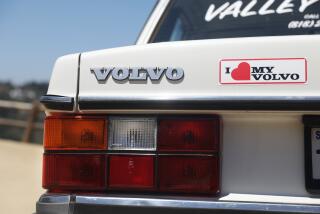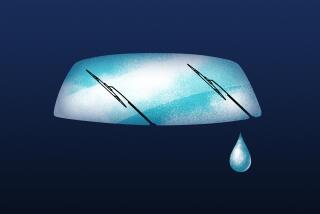Kids Loved to Hate Those Clunky Jalopies
- Share via
One day in the ‘50s, my father came home with a new car, a white Nash Ambassador. It looked like a bathtub turned upside down, and we kids tried to hide our disappointment. Why couldn’t we have a Ford or a Chevy, like other families?
For my father, however, it was the ideal family car. Four-door, it was roomy and even had front seats that reclined into beds, lying flush with the back seats. This would be good for my mother, he said, when we went on trips. When she got tired, she could put her seat back.
My father went one better. He designed a wood frame that would extend, on the passenger side, from the dashboard to the rear window ledge. On this he put a foam mattress cut to fit. We were the only family I knew that had a car with bunk beds.
This arrangement came in handy during our trip to California to spend Christmas with the grandparents. Because we had only two weeks for the trip, my parents decided to drive “straight through,” as my father would say, as if Route 66 were a long tunnel that ran beneath the American continent.
While one parent was driving, the other could stretch out on the bunk and sleep. I only remember that one Saturday night in December, provisioned with sandwiches, juice and bread sticks, we entered that tunnel in our pale Ambassador and emerged three nights and two days later into the bright sunlight of Los Angeles. The trip would have been good training, I believe, for astronauts.
Gradually we grew accustomed to the Nash and stopped hoping for a more popular model. It did have its features. One of them was a button in the middle of the steering wheel where the horn usually is. When pushed, it would shift the car out of overdrive, giving it a better gear ratio for passing. I’m sure other drivers were impressed.
Another feature was a gas tank cap behind the left rear taillight. To find it, you had to lift the whole taillight assembly. One Easter when we were hiding eggs in the yard for my younger sister, I put one behind the taillight, then forgot about it. It must have made a nice surprise for the gas station attendant, especially if the passing of several days had affected its chemistry.
For several years, my father bought Nashes. Earlier he had a Studebaker, which I liked because of its sleek look and reputation for speed. But he sold it the next year.
During my fourth-grade year, he came home with a Kaiser. Heaven only knows where he found it. I’ve never seen one since. Well used, it was our family’s first “second” car. We had moved to California, and my mother needed a car to get to her new job. A faded pea green, its distinguishing feature was that it had large buttons instead of door handles.
When you wanted to open the door, you’d smack the button hard with your hand, and it would pop open. Also, its rear doors opened from the front, not the rear, to make it easier to board. For obvious reasons, these were features no other auto maker sought to copy. This car stayed with us only a few months.
My father’s attraction to weird cars didn’t stop there. In 1961 he purchased, as another second car, a 1953 Hudson, a maroon tank of a car my brothers and I drove when we moved across the country.
On a narrow road in Iowa, we sideswiped a dump truck. Stunned, my brother drove on a half mile or so before he realized what had happened. He stopped, turned around and drove back to the scene of the accident. The truck was still there, disabled in the ditch. The Hudson merely had its driver’s side punched in from front to back fender. We stayed for the police report, then drove on.
Nor was my father’s curious taste confined to American models. In 1956, he bought a Renault, a tiny blue caricature of a car that looked as if it had been built for Disneyland rides. But it would get--my father would beam with pride--45 miles to a gallon. To this day, I don’t know how two adults and four kids managed to wedge into its bug-like shape, which we had to do when the first car was in the garage.
Then in about 1959, my father became the first person in our region to buy a Saab. Do not confuse this with the Saabs of today. This was a three-cylinder--yes, three--dark-green get-about that again got excellent gas mileage, except when it rained and water leaked into the distributor cap. Then it got no mileage at all.
I was in seventh grade, and my friend, whose father ran a car dealership, brought to school preview photos of the new 1959 Chevy models with the graceful wing design in the rear. I tried hard not to think about the Saab.
My father’s attraction to strangeness was contagious. His best friend decided one day that the perfect family car would be a Checker. That’s Checker as in cab. Roomy, reliable, take the wear and tear--what could be more practical?
So he drove to some place in Ohio where they make Checkers and purchased a “civilian” model, a gray one without the checkered paint job. A father of three boys, he bragged for months about what a practical thing he had done. Meanwhile, his adolescent children rolled their eyes at us.
Just maybe, these two fathers knew what they were doing. Perhaps they knew, as we became old enough to get our driving permits, that it would slow us down. Can you imagine: You’ve just got your license. You finally get the courage to ask this tall blond girl you’ve been admiring for a long time out for a date. “I’ll swing by about 7,” you say, “in the Checker.” Or the Nash, or the Hudson.
Sometimes I wonder where those old cars are now--perhaps in the far end of a country junkyard, doorless, partless, dozing in eternal disarray. Still their ghosts befriend and haunt me. Let them rust in peace.
More to Read
Sign up for The Wild
We’ll help you find the best places to hike, bike and run, as well as the perfect silent spots for meditation and yoga.
You may occasionally receive promotional content from the Los Angeles Times.






